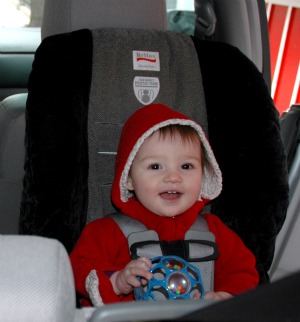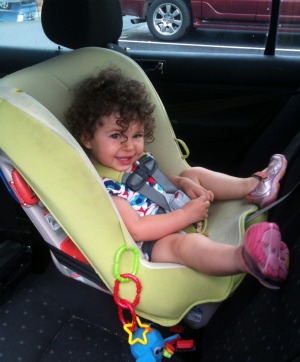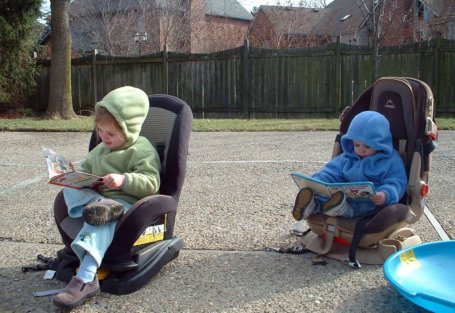Picture of Girl Od in Car With 10 Month Old in Back Seat
Resources
Keeping Your Kids Happy
Posted in: Tips & Tricks
We've all been there: You're on a long car trip, or even just on the daily carpool route, and your kids are NOT HAPPY. They scream and cry and don't want to be in their car seats. Think about it–Would you want to be strapped down in the car for long periods of time every day? Kids get bored and uncomfortable just like adults. Here are some ways to keep your kids happy, or at least happier, in the car.
Infants
Toddlers
Kids Who Act Up in the Car
Infants
-
 Make sure your newborn's straps are tight enough. Newborns are comforted by a tight 5-point harness, since it mimicks swaddling, and may drift off to sleep once the car starts moving.
Make sure your newborn's straps are tight enough. Newborns are comforted by a tight 5-point harness, since it mimicks swaddling, and may drift off to sleep once the car starts moving. - Make sure your infant is not too cold OR too hot. Babies have trouble regulating their own temperature and can overheat easily, even in winter if they are bundled up and then put in a warm car. Read more about keeping your baby warm Cold Weather Tips and cool Warm Weather Tips.
- Many older infants become unhappy in the car seat around 6-8 months. Babies this age are just becoming more aware of their surroundings and don't want to be confined in the car seat. Early sitters and movers will be more unhappy than kids content to stay in one place. Many of these children are happier once they transition to a rear-facing convertible car seat, because convertible seats sit higher up off the vehicle seat and are more upright, allowing the child to perhaps see out the rear-window, and at the very least to sit up. See how your child likes to rest outside of the car seat and take that into consideration when deciding if its time to move into a convertible seat.
- Check to see that the sun isn't shining into the baby's eyes. A stick-on sunshade or adjusting the car seat's own built-in sunshade may make the baby happier.
- While your child can't see you when you're driving, even very young babies can recognize the voices of their parents. Talk to your baby – or play music and sing to it. You don't necessarily need to listen to "baby" songs – kids like music with a beat, so many of your favorite songs might become the baby's favorites too!
- It is developmentally appropriate for older infants to dislike the car seat and other forms of restraint (like high chairs or strollers). These restraints limit a child's mobility and freedom; most kids would much rather be crawling around exploring the world around them instead of strapped into a car seat. But while its disconcerting to hear a baby cry, it's also important to realize that it's unlikely that the baby is crying out of pain. Crying is the baby's only form of communication. He might be trying to ask "Are we there yet? I want to get out and play!" As any pediatrician can tell you, the crying baby is the most reassuring baby, because you know his airway is open.
Toddlers
-
 Toddlers are even more apt to dislike the car seat and other forms of restraint, like the stroller and high chair. You can bet that your unhappy kid wants nothing more than to be out of the car seat. An older toddler can understand simple directions and can be reminded (perhaps constantly) that "We need to be in the car seat if we are in the car. The car seat will keep you safe."
Toddlers are even more apt to dislike the car seat and other forms of restraint, like the stroller and high chair. You can bet that your unhappy kid wants nothing more than to be out of the car seat. An older toddler can understand simple directions and can be reminded (perhaps constantly) that "We need to be in the car seat if we are in the car. The car seat will keep you safe." - Distraction works wonders. Set aside some soft toys (ones that pass the ouch test) that are only for use in the car. Soft books, blocks, cards, dolls, etc, are all great toys and if they are only allowed in the car, they become "special," making a ride in the car something to look forward to. Stickers are great for older kids who won't try to eat them.
- Play music and sing with your toddler.
- Older kids who can be trusted with food will enjoy eating cereal and other non-chokeable treats in the car.
- If your rear-facing toddler can see out the rear-window, talk to him about what he sees out there.
- It often helps to NOT sit in the back seat with your toddler. Many children can't understand why they can't come out of the car seat and sit with Mommy or Daddy. These kids will often entertain themselves if left alone with a few soft toys and some music, albeit after a short amount of protest.
Kids Who Act Up in the Car
This section is for parents of kids who are having behavioral issues in the car. We all know who these kids are–the ones who unbuckle themselves as soon as you reach the highway, the ones who wiggle out of their shoulder straps, and the ones who just don't stop SCREAMING.
- As you are walking to the car, give your child clear instructions as to how they should behave in the car – outlining your expectations and the consequences should they misbehave. For example "We are going to get in the car to go to school. You must wear your straps in the car. We do not take our straps off until Mommy says so. If you take your straps off you will get a time out when we reach the school parking lot."
- Kids will work for attention – whether it is positive or negative attention. Not only that, but kids, unlike adults, have trouble distinguishing between positive attention and negative attention. Reinforce the behavior you want, which means FREQUENTLY praising the child for good behavior. If you are buckling your child in and she is cooperating nicely you should say somthing like "Mommy is so proud of you for getting buckled like a big girl." If it's two minutes into the car ride and she's still sitting nicely; yup, you guessed it, praise her again. Two minutes later, praise her again. Kids have very short attention spans – so the praise, especially in the beginning, needs to be VERY frequent.
-
 Use a sticker chart. Kids love visual reminders of their good behavior – and it only encourages them to continue that behavior so they get another sticker. If your child is worst behaved when you are buckling them in, talk to them on the way to the car about the behavior you expect and the reward for such behavior (i.e. a sticker, or getting to read a story with you, or something else that is NOT FOOD). If they behave well while you buckle them in don't make them wait til the end of the car ride for a sticker, give them one right then. If they also typically misbehave during the trip, talk to them on the way to the car about the behavior you expect, and give them a sticker at the end of the car trips that they behaved nicely. Keep your sticker chart in the car if it helps!
Use a sticker chart. Kids love visual reminders of their good behavior – and it only encourages them to continue that behavior so they get another sticker. If your child is worst behaved when you are buckling them in, talk to them on the way to the car about the behavior you expect and the reward for such behavior (i.e. a sticker, or getting to read a story with you, or something else that is NOT FOOD). If they behave well while you buckle them in don't make them wait til the end of the car ride for a sticker, give them one right then. If they also typically misbehave during the trip, talk to them on the way to the car about the behavior you expect, and give them a sticker at the end of the car trips that they behaved nicely. Keep your sticker chart in the car if it helps! - If your child has a favorite book or small toy, save it for the car – this way it makes them look forward to riding in the car as they get to play with that toy or read that special book.
- Let kids who are fascinated by the buckles and/or straps buckle and strap themselves in. As the child buckles and straps herself in, tell her what a good job she's doing using the car seat the right way. This allows the child to feel in control of her car seat and feel like she's accomplished something.
- Make a story about using the car seat (with your child) and read it to your child often. To you it may seem like routine that everytime you go in the car you strap your child in – but perhaps your child doesn't understand the routine (even though you do it 5 times a day!). Making things routine – and helping your child understand the steps to the routine – alleviates some of the anxiety associated with transitioning from one activity to another. Picture books are a great way of teaching your child the routine – while also making it fun as most toddlers love reading books, especially ones about them! Here is an example of a story you can write with your child – print it out and read it with them as you go to the car and buckle them in. If you have a digital or cell phone camera, take a picture of the steps and incorporate that into your story so your child can see exactly what is going to happen. Page 1: Mommy and I walk to the car. Page 2: Mommy opens the car door. Page 3: I climb into my seat like a big girl! Page 4: Mommy puts the straps over my shoulders and over my hips. Page 5: I help Mommy with the easy part (the chest clip). Page 6: Mommy does the hard part (buckles between the legs). Page 7: Mommy makes my straps snug so they give me a hug. Page 8: Mommy gives me a high five and a hug. Page 9: Mommy sits in her seat and wears her seat belt snug so it gives her a hug. Page 10: Mommy starts the car – I like the sound of the engine! Page 11: Off we go!
- If your child starts misbehaving, STAY CALM. Your goal is to give her NO ATTENTION for her misbehavior – this means that you don't show her any facial expressions in reaction to it (typically people show an angry face or laugh – both of which encourage the child to continue screaming). For wigglers and unbucklers, you will obviously need to find a safe place to pull over and tighten the child's straps or rebuckle the harness- and I would recommend giving the child a time out right then or immediately when you get to your destination.
Leave a Reply
You must be logged in to post a comment.
Picture of Girl Od in Car With 10 Month Old in Back Seat
Source: https://thecarseatlady.com/keeping-your-kids-happy/
0 Response to "Picture of Girl Od in Car With 10 Month Old in Back Seat"
ارسال یک نظر